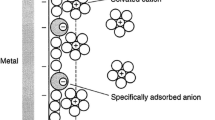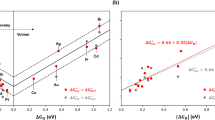Abstract
In the temperature range 873–1123 K, transport numbers of oxygen ions and protons are determined in the system (H2 + H2O), Me/BaCe0.9Nd0.1O3-α/Me,(H2 + H2O), where Me = Ag, Au, Pt, Ni, by the emf and current methods. The determined transport numbers are independent of the determination method, the electrode material, the current direction (anodic and cathodic polarization of the electrode), polarizability of electrodes, and the partial water (hydrogen) pressure in the gas phase. This unambiguously suggests that the transport numbers refer to the solid electrolyte, and not the electrochemical system as a whole. It also follows that partial currents of the hydrogen ionization and the oxygen ion discharge are determined by the transport numbers of protons and oxygen ions in the electrolyte. At a constant temperature, their ratio is affected by neither the electrode potential nor the gas phase composition, i.e., both electrode reactions have a common limiting step (or steps).
Similar content being viewed by others
References
Iwahara, H., Esaka, T., Uchida, H., and Maeda, N.,Solid State Ionics, 1981, vol. 3/4, p. 359.
Iwahara, H., Esaka, T., Uchida, H., Yamauchi, T., and Ogaki, K.,Solid State Ionics, 1986, vol. 18/19, p. 1003.
Iwahara, H., Uchida, H., and Tanaka, S.,Solid State Ionics, 1983, vol. 9/10, p. 1021.
Nagata, K., Nischino, M., and Goto, K.S.,J. Electrochem. Soc., 1987, vol. 134, p. 1850.
Sharova, N.V.,Cand. Sci. (Chem.) Dissertation, Yekaterinburg: Inst. High-Temp. Electrochem., Ural Div., Russ. Acad. Sci., 1998.
Arestova, N.V. and Gorelov, V.P.,Elektrokhimiya, 1994, vol. 30, p. 988.
Gorelov, V.P., Sharova, N.V., and Sokolova, Yu.V.,Elektrokhimiya, 1997, vol. 33, p. 1455.
Norby, T. and Kofstad, P.,Solid State Ionics, 1986, vol. 20, p. 169.
Frade, J.R.,Solid State Ionics, 1995, vol. 78, p. 87.
Iwahara, H., Yajima, T., and Uschida, H.,Solid State Ionics, 1994, vol. 70/71, p. 267.
Bonanos, N., Knight, K.S., and Ellis, B.,Solid State Ionics, 1995, vol. 79, p. 161.
Perfil’ev, M.V., Demin, A.K., Kuzin, B.L., and Lipilin, A.S.,Vysokotemperaturnyi elektroliz gazov (The High-Temperature Electrolysis of Gases), Moscow: Nauka, 1988, p. 145.
Author information
Authors and Affiliations
Additional information
Deceased.
Rights and permissions
About this article
Cite this article
Kuzin, B.L., Beresnev, S.M., Bannykh, A.V. et al. Transport numbers of H+ and O2- in the electrochemical system (H2 + H2O),Me/BaCe0.9Nd0.1O3-α/Me,(H2 + H2O). Russ J Electrochem 36, 424–430 (2000). https://doi.org/10.1007/BF02756951
Received:
Issue Date:
DOI: https://doi.org/10.1007/BF02756951




